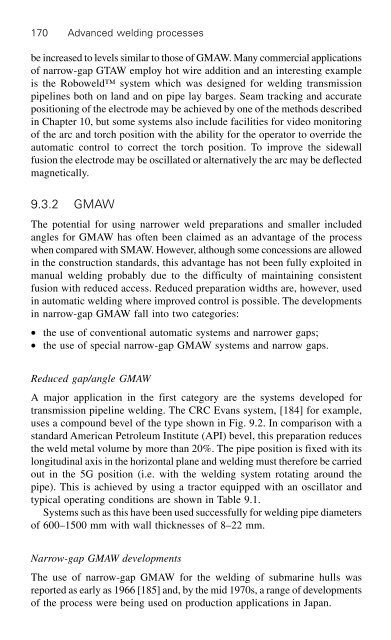Advanced Welding Processes: Technologies and Process Control
Advanced Welding Processes: Technologies and Process Control
Advanced Welding Processes: Technologies and Process Control
Create successful ePaper yourself
Turn your PDF publications into a flip-book with our unique Google optimized e-Paper software.
170<br />
<strong>Advanced</strong> welding processes<br />
be increased to levels similar to those of GMAW. Many commercial applications<br />
of narrow-gap GTAW employ hot wire addition <strong>and</strong> an interesting example<br />
is the Roboweld system which was designed for welding transmission<br />
pipelines both on l<strong>and</strong> <strong>and</strong> on pipe lay barges. Seam tracking <strong>and</strong> accurate<br />
positioning of the electrode may be achieved by one of the methods described<br />
in Chapter 10, but some systems also include facilities for video monitoring<br />
of the arc <strong>and</strong> torch position with the ability for the operator to override the<br />
automatic control to correct the torch position. To improve the sidewall<br />
fusion the electrode may be oscillated or alternatively the arc may be deflected<br />
magnetically.<br />
9.3.2 GMAW<br />
The potential for using narrower weld preparations <strong>and</strong> smaller included<br />
angles for GMAW has often been claimed as an advantage of the process<br />
when compared with SMAW. However, although some concessions are allowed<br />
in the construction st<strong>and</strong>ards, this advantage has not been fully exploited in<br />
manual welding probably due to the difficulty of maintaining consistent<br />
fusion with reduced access. Reduced preparation widths are, however, used<br />
in automatic welding where improved control is possible. The developments<br />
in narrow-gap GMAW fall into two categories:<br />
∑ the use of conventional automatic systems <strong>and</strong> narrower gaps;<br />
∑ the use of special narrow-gap GMAW systems <strong>and</strong> narrow gaps.<br />
Reduced gap/angle GMAW<br />
A major application in the first category are the systems developed for<br />
transmission pipeline welding. The CRC Evans system, [184] for example,<br />
uses a compound bevel of the type shown in Fig. 9.2. In comparison with a<br />
st<strong>and</strong>ard American Petroleum Institute (API) bevel, this preparation reduces<br />
the weld metal volume by more than 20%. The pipe position is fixed with its<br />
longitudinal axis in the horizontal plane <strong>and</strong> welding must therefore be carried<br />
out in the 5G position (i.e. with the welding system rotating around the<br />
pipe). This is achieved by using a tractor equipped with an oscillator <strong>and</strong><br />
typical operating conditions are shown in Table 9.1.<br />
Systems such as this have been used successfully for welding pipe diameters<br />
of 600–1500 mm with wall thicknesses of 8–22 mm.<br />
Narrow-gap GMAW developments<br />
The use of narrow-gap GMAW for the welding of submarine hulls was<br />
reported as early as 1966 [185] <strong>and</strong>, by the mid 1970s, a range of developments<br />
of the process were being used on production applications in Japan.


